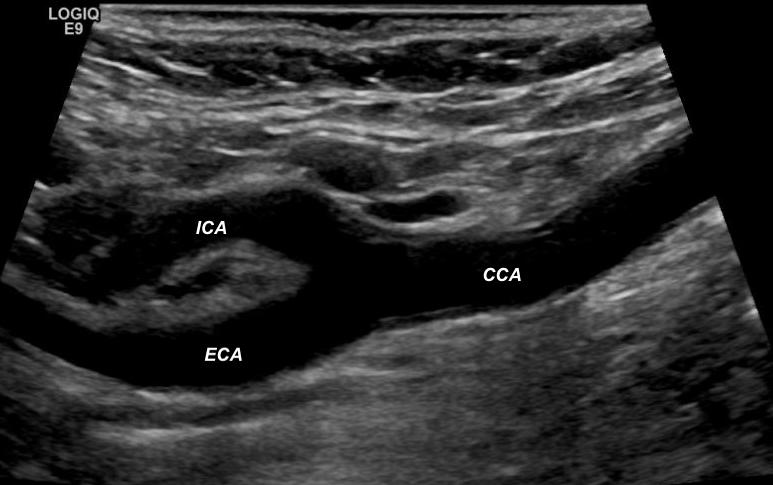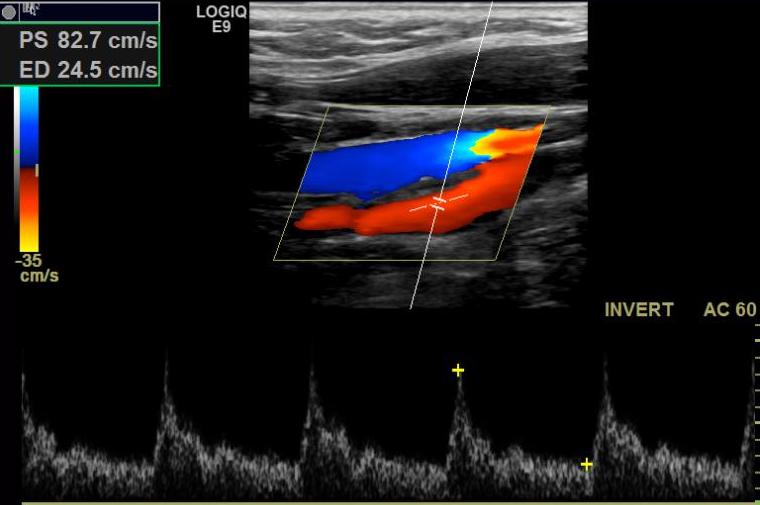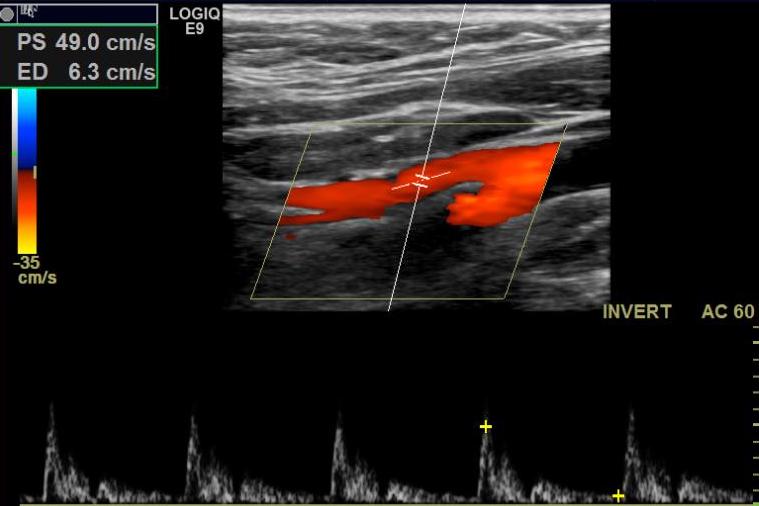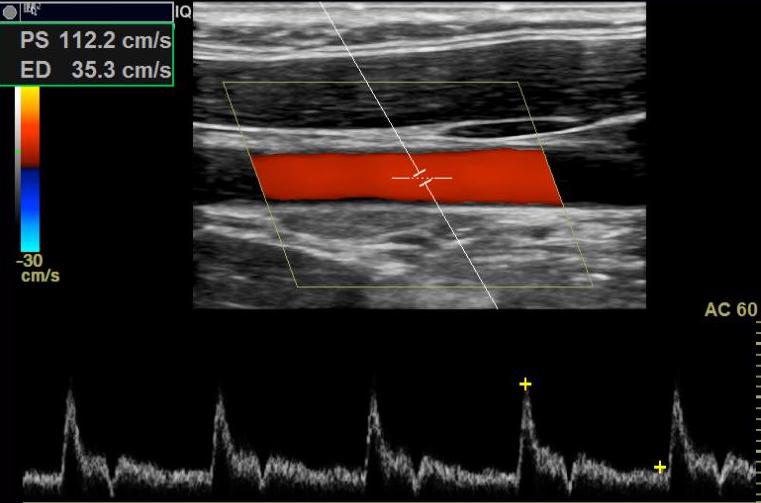[1]
Sigel B. A brief history of Doppler ultrasound in the diagnosis of peripheral vascular disease. Ultrasound in medicine & biology. 1998 Feb:24(2):169-76
[PubMed PMID: 9550175]
[2]
Fleming SE, Bluth EI, Milburn J. Role of sonography in the evaluation of carotid artery stents. Journal of clinical ultrasound : JCU. 2005 Sep:33(7):321-8
[PubMed PMID: 16196004]
[3]
Flaherty ML, Kissela B, Khoury JC, Alwell K, Moomaw CJ, Woo D, Khatri P, Ferioli S, Adeoye O, Broderick JP, Kleindorfer D. Carotid artery stenosis as a cause of stroke. Neuroepidemiology. 2013:40(1):36-41. doi: 10.1159/000341410. Epub 2012 Oct 11
[PubMed PMID: 23075828]
[4]
Nezu T, Hosomi N. Usefulness of Carotid Ultrasonography for Risk Stratification of Cerebral and Cardiovascular Disease. Journal of atherosclerosis and thrombosis. 2020 Oct 1:27(10):1023-1035. doi: 10.5551/jat.RV17044. Epub 2020 Aug 29
[PubMed PMID: 32863299]
[5]
Kau T, Sinzig M, Gasser J, Lesnik G, Rabitsch E, Celedin S, Eicher W, Illiasch H, Hausegger KA. Aortic development and anomalies. Seminars in interventional radiology. 2007 Jun:24(2):141-52. doi: 10.1055/s-2007-980040. Epub
[PubMed PMID: 21326792]
[6]
Dungan DH, Heiserman JE. The carotid artery: embryology, normal anatomy, and physiology. Neuroimaging clinics of North America. 1996 Nov:6(4):789-99
[PubMed PMID: 8824131]
[7]
Schulz UG, Rothwell PM. Major variation in carotid bifurcation anatomy: a possible risk factor for plaque development? Stroke. 2001 Nov:32(11):2522-9
[PubMed PMID: 11692011]
[8]
. AIUM Practice Parameter for the Performance of an Ultrasound Examination of the Extracranial Cerebrovascular System. Journal of ultrasound in medicine : official journal of the American Institute of Ultrasound in Medicine. 2016 Sep:35(9):1-11. doi: 10.7863/ultra.35.9.1. Epub
[PubMed PMID: 27574121]
[9]
FRANKLIN DL, SCHLEGEL W, RUSHMER RF. Blood flow measured by Doppler frequency shift of back-scattered ultrasound. Science (New York, N.Y.). 1961 Aug 25:134(3478):564-5
[PubMed PMID: 13701432]
[10]
Burns PN. The physical principles of Doppler and spectral analysis. Journal of clinical ultrasound : JCU. 1987 Nov-Dec:15(9):567-90
[PubMed PMID: 2960698]
[12]
Scoutt LM, Gunabushanam G. Carotid Ultrasound. Radiologic clinics of North America. 2019 May:57(3):501-518. doi: 10.1016/j.rcl.2019.01.008. Epub 2019 Feb 22
[PubMed PMID: 30928074]
[13]
Park TH. Evaluation of Carotid Plaque Using Ultrasound Imaging. Journal of cardiovascular ultrasound. 2016 Jun:24(2):91-5. doi: 10.4250/jcu.2016.24.2.91. Epub 2016 Jun 22
[PubMed PMID: 27358696]
[15]
Logason K, Bärlin T, Jonsson ML, Boström A, Hårdemark HG, Karacagil S. The importance of Doppler angle of insonation on differentiation between 50-69% and 70-99% carotid artery stenosis. European journal of vascular and endovascular surgery : the official journal of the European Society for Vascular Surgery. 2001 Apr:21(4):311-3
[PubMed PMID: 11359330]
[16]
Meyer JI, Khalil RM, Obuchowski NA, Baus LK. Common carotid artery: variability of Doppler US velocity measurements. Radiology. 1997 Aug:204(2):339-41
[PubMed PMID: 9240517]
[17]
Saad AA, Loupas T, Shapiro LG. Computer vision approach for ultrasound Doppler angle estimation. Journal of digital imaging. 2009 Dec:22(6):681-8. doi: 10.1007/s10278-008-9131-2. Epub 2008 May 17
[PubMed PMID: 18488268]
[18]
Tahmasebpour HR, Buckley AR, Cooperberg PL, Fix CH. Sonographic examination of the carotid arteries. Radiographics : a review publication of the Radiological Society of North America, Inc. 2005 Nov-Dec:25(6):1561-75
[PubMed PMID: 16284135]
[19]
Zwiebel WJ. Spectrum analysis in carotid sonography. Ultrasound in medicine & biology. 1987 Oct:13(10):625-36
[PubMed PMID: 3318070]
[20]
Frauchiger B, Schmid HP, Roedel C, Moosmann P, Staub D. Comparison of carotid arterial resistive indices with intima-media thickness as sonographic markers of atherosclerosis. Stroke. 2001 Apr:32(4):836-41
[PubMed PMID: 11283379]
[21]
Park JH, Shin JW, Lee JH. Unilateral Pulsus Parvus et Tardus Waveform Discovered during Carotid Artery Doppler Examination: a Clue of Proximal Carotid Artery Occlusion. Korean circulation journal. 2019 Dec:49(12):1203-1205. doi: 10.4070/kcj.2019.0178. Epub
[PubMed PMID: 31760708]
[23]
Walker HK, Hall WD, Hurst JW, Morris DC. The Carotid Pulse. Clinical Methods: The History, Physical, and Laboratory Examinations. 1990:():
[PubMed PMID: 21250154]
[24]
Rohren EM, Kliewer MA, Carroll BA, Hertzberg BS. A spectrum of Doppler waveforms in the carotid and vertebral arteries. AJR. American journal of roentgenology. 2003 Dec:181(6):1695-704
[PubMed PMID: 14627599]
[25]
Chirinos JA, Akers SR, Vierendeels JA, Segers P. A Unified Mechanism for the Water Hammer Pulse and Pulsus Bisferiens in Severe Aortic Regurgitation: Insights from Wave Intensity Analysis. Artery research. 2018 Mar:21():9-12. doi: 10.1016/j.artres.2017.12.002. Epub 2017 Dec 21
[PubMed PMID: 29576810]
[26]
Ginat DT, Bhatt S, Sidhu R, Dogra V. Carotid and vertebral artery Doppler ultrasound waveforms: a pictorial review. Ultrasound quarterly. 2011 Jun:27(2):81-5. doi: 10.1097/RUQ.0b013e31821c7f6a. Epub
[PubMed PMID: 21606790]
[27]
Horrow MM, Stassi J. Sonography of the vertebral arteries: a window to disease of the proximal great vessels. AJR. American journal of roentgenology. 2001 Jul:177(1):53-9
[PubMed PMID: 11418397]
[28]
Kronick MD, Chopra A, Swamy S, Brar V, Jung E, Abraham CZ, Liem TK, Landry GJ, Moneta GL. Peak systolic velocity and color aliasing are important in the development of duplex ultrasound criteria for external carotid artery stenosis. Journal of vascular surgery. 2020 Sep:72(3):951-957. doi: 10.1016/j.jvs.2019.10.099. Epub 2020 Jan 19
[PubMed PMID: 31964570]
[29]
Ferguson GG, Eliasziw M, Barr HW, Clagett GP, Barnes RW, Wallace MC, Taylor DW, Haynes RB, Finan JW, Hachinski VC, Barnett HJ. The North American Symptomatic Carotid Endarterectomy Trial : surgical results in 1415 patients. Stroke. 1999 Sep:30(9):1751-8
[PubMed PMID: 10471419]
[30]
Grant EG, Benson CB, Moneta GL, Alexandrov AV, Baker JD, Bluth EI, Carroll BA, Eliasziw M, Gocke J, Hertzberg BS, Katanick S, Needleman L, Pellerito J, Polak JF, Rholl KS, Wooster DL, Zierler RE. Carotid artery stenosis: gray-scale and Doppler US diagnosis--Society of Radiologists in Ultrasound Consensus Conference. Radiology. 2003 Nov:229(2):340-6
[PubMed PMID: 14500855]
Level 3 (low-level) evidence
[31]
North American Symptomatic Carotid Endarterectomy Trial Collaborators, Barnett HJM, Taylor DW, Haynes RB, Sackett DL, Peerless SJ, Ferguson GG, Fox AJ, Rankin RN, Hachinski VC, Wiebers DO, Eliasziw M. Beneficial effect of carotid endarterectomy in symptomatic patients with high-grade carotid stenosis. The New England journal of medicine. 1991 Aug 15:325(7):445-53
[PubMed PMID: 1852179]
[33]
Osiro S, Zurada A, Gielecki J, Shoja MM, Tubbs RS, Loukas M. A review of subclavian steal syndrome with clinical correlation. Medical science monitor : international medical journal of experimental and clinical research. 2012 May:18(5):RA57-63
[PubMed PMID: 22534720]
[34]
Liljeqvist L, Ekeström S, Nordhus O. Monitoring direction of vertebral artery blood flow by Doppler shift ultrasound in patients with suspected "subclavian steal'. Acta chirurgica Scandinavica. 1981:147(6):421-4
[PubMed PMID: 7324774]
[35]
Khan S, Cloud GC, Kerry S, Markus HS. Imaging of vertebral artery stenosis: a systematic review. Journal of neurology, neurosurgery, and psychiatry. 2007 Nov:78(11):1218-25
[PubMed PMID: 17287234]
Level 1 (high-level) evidence




